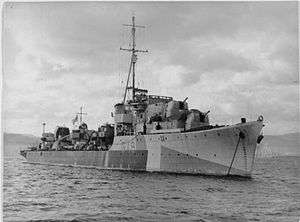HMS Obedient (G48)
 HMS Obedient during the Second World War | |
| History | |
|---|---|
| Name: | HMS Obedient |
| Ordered: | 3 September 1939 |
| Builder: | William Denny and Brothers, Dumbarton |
| Laid down: | 22 May 1940 |
| Launched: | 30 April 1942 |
| Commissioned: | 30 October 1942 |
| Identification: | Pennant number G48 later D248 |
| Honours and awards: |
|
| Fate: | Scrapped 1962 |
| Badge: | On a Field Blue, a sea dog sejant Proper, collared Gold |
| General characteristics | |
| Class and type: | O-class destroyer |
| Displacement: | 1,540 long tons (1,560 t) standard |
| Length: | 345 ft (105 m) o/a |
| Beam: | 35 ft (11 m) |
| Draught: | 13 ft 6 in (4.11 m) |
| Propulsion: |
|
| Speed: | 37 knots (43 mph; 69 km/h) |
| Range: | 3,850 nmi (7,130 km) at 20 kn (23 mph; 37 km/h) |
| Endurance: | 472 tons oil |
| Complement: | 176+ |
| Armament: |
|
HMS Obedient was an O-class destroyer of the Royal Navy. She was built by William Denny and Brothers of Dumbarton, between 1940 and 1942. During Warship Week in 1942 she was adopted by the civil community of Lymington, United Kingdom. She was scrapped in 1962.
Service history
Second World War service
On commissioning Obedient joined the 17th Destroyer Flotilla for service with the Home Fleet. During the Second World War she escorted Arctic convoys in 1942 and 1944, and Atlantic convoys in 1943, taking part in the Battle of the Barents Sea in 1942.
During June 1944 she was deployed in the English Channel for patrol duties to assist with the Normandy landings. In April 1945 she was converted for mine-laying duties and undertook mine-laying duties in the Northwestern approaches.[1]
Postwar service
In August 1946 Obedient underwent refit. Following this she took part in Operation "Deadlight", the destruction of surrendered U-Boats in the Northwest Approaches. She then joined the Portsmouth Local Flotilla for use by the Torpedo School. The ship was reduced to Reserve status in October 1947 at Sheerness and was refitted in 1949. She was re-commissioned on 17 October 1952 and deployed at Portsmouth for service in the Local Flotilla. In 1953 she took part in the Fleet Review to celebrate the Coronation of Queen Elizabeth II.[2]
After July 1953 she was used for Air-Sea rescue duties during air operations by aircraft carriers in the English Channel. After acceptance into the Reserve Fleet at Chatham in December that year she briefly commissioned for further service for trials in February 1956 but then returned to Reserve at Chatham. A proposal to convert this ship and Obdurate for use as anti-submarine frigates was not implemented and she was laid-up in Reserve at Hartlepool in 1957.[3] The ship was put on the Disposal List in 1961 and sold to BISCO for demolition by Hughes Bolcow, She arrived in tow at the Breakers yard in Blyth on 19 October 1962.
Notes
- ↑ "HMS Obedient (G48) - O-class destroyer". naval-history.net. Retrieved 4 April 2015.
- ↑ Souvenir Programme, Coronation Review of the Fleet, Spithead, 15th June 1953, HMSO, Gale and Polden
- ↑ Critchley, Mike (1982). British Warships Since 1945: Part 3: Destroyers. Liskeard, UK: Maritime Books. p. 18. ISBN 0-9506323-9-2.
References
- Colledge, J. J.; Warlow, Ben (2006) [1969]. Ships of the Royal Navy: The Complete Record of all Fighting Ships of the Royal Navy (Rev. ed.). London: Chatham Publishing. ISBN 978-1-86176-281-8. OCLC 67375475.
- Connell, G. G. (1982). Arctic Destroyers: The 17th Flotilla. London: William Kimber. ISBN 0-7183-0428-4.
- English, John (2001). Obdurate to Daring: British Fleet Destroyers 1941–45. Windsor, UK: World Ship Society. ISBN 978-0-9560769-0-8.
- Friedman, Norman (2006). British Destroyers & Frigates: The Second World War and After. Annapolis, Maryland: Naval Institute Press. ISBN 1-86176-137-6.
- Lenton, H. T. (1998). British & Empire Warships of the Second World War. Annapolis, Maryland: Naval Institute Press. ISBN 1-55750-048-7.
- Raven, Alan; Roberts, John (1978). War Built Destroyers O to Z Classes. London: Bivouac Books. ISBN 0-85680-010-4.
- Rohwer, Jürgen (2005). Chronology of the War at Sea 1939-1945: The Naval History of World War Two (Third Revised ed.). Annapolis, Maryland: Naval Institute Press. ISBN 1-59114-119-2.
- Whitley, M. J. (1988). Destroyers of World War 2. Annapolis, Maryland: Naval Institute Press. ISBN 0-87021-326-1.